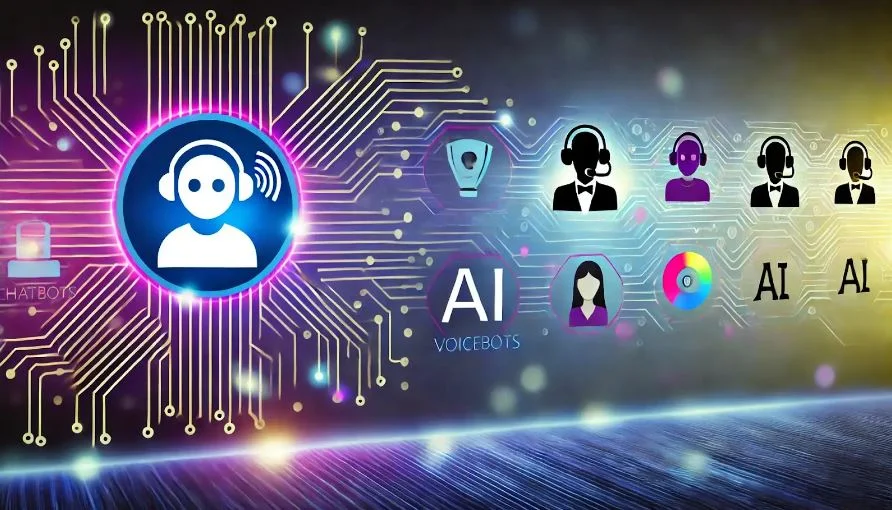Are you struggling to manage overwhelming call volumes or long customer wait times? Many businesses face these challenges, but the solution is already here: AI-based call centers. By integrating artificial intelligence, call centers can automate repetitive tasks, improve customer interactions, and boost overall efficiency.
Whether it’s voice bots handling routine inquiries or AI analyzing call data in real time, the right tech can transform how your business communicates. Let’s explore the essential steps to set up a seamless AI-powered call center, ensuring smooth operations and satisfied customers.
Steps to Power an AI Call Center
Here are some popular steps to power your AI-driven call center:
Step 1: Understand Your Needs and Goals
Before diving into AI solutions, it’s crucial to clearly define what your call center needs. Start by identifying the pain points—like frequent customer complaints, long handling times, or repetitive inquiries.
Ask yourself, where is the bottleneck? Is it in routing calls, managing customer data, or handling after-hours support? Knowing these specifics will help you choose AI tools that address your exact challenges.
It’s also important to set clear goals. For example, do you want to reduce wait times, improve customer satisfaction, or increase the number of calls your team can handle in a day? When you have well-defined objectives, it’s easier to measure the success of your AI integration.
A clear plan will help guide the implementation, ensuring that the AI system aligns with your business goals.
Step 2: Choose the Right AI Tools
The power of AI lies in its versatility, but selecting the right tools makes all the difference. Start by exploring technologies like AI voicebots, chatbots, and natural language processing (NLP). Each tool has its strengths.
For instance, voice bots can handle straightforward tasks like answering FAQs, directing calls, or verifying identity, freeing up your agents for more complex issues.
On the other hand, chatbots can manage online customer interactions 24/7, ensuring your clients always get immediate responses.
Consider integrating speech recognition and sentiment analysis as well. These tools help your system understand the tone and intent behind a customer’s words, providing agents with real-time feedback or routing calls to the most appropriate department.
For example, if a caller sounds frustrated, the AI can prioritize that call and alert a human agent to step in.
A robust AI toolset is more than just efficient; it’s adaptable. Make sure your chosen tools can easily integrate with existing systems like CRM software, enabling seamless data flow between human agents and AI.
Ultimately, the right AI calling solutions will streamline your operations, boost customer satisfaction, and help your team focus on what matters most—building strong, lasting relationships with customers.
Step 3: Integrate AI with Existing Systems
Seamless integration is the backbone of a successful AI-powered call center. It’s not enough to just add AI tools; they need to work smoothly with your current systems, such as CRM software, IVR systems, and databases.
This integration allows for real-time data exchange, ensuring that agents and AI can access accurate information about customer interactions, purchase history, and preferences.
For example, when a customer calls, the AI can quickly pull up relevant data from your CRM, like previous issues or past purchases. This helps the AI or human agent offer a personalized experience, cutting down on the time it takes to resolve the issue.
Proper integration means your AI tools will enhance, not disrupt, your existing workflow. Ensure your IT team or service provider can handle these connections efficiently, allowing your AI systems to deliver their full potential.
Step 4: Train AI and Human Agents
AI systems need to be trained just like humans. The success of your AI depends on how well it understands your business and customer base. Start by feeding it relevant data, such as call recordings, chat transcripts, and customer feedback.
The more accurate and diverse the data, the better the AI will learn to understand different accents, tones, and phrases that customers may use.
Human agents need training, too. They should learn how to work alongside AI, using it to streamline their tasks.
For instance, an agent might use AI-generated suggestions to respond faster or rely on automated call summaries to focus on problem-solving rather than data entry. Providing consistent training will ensure your team feels confident using AI tools and can step in when a complex issue requires a human touch.
This collaboration between AI and humans creates a more efficient and effective call center environment.
Step 5: Automate Repetitive Tasks
One of the biggest advantages of AI in a call center is its ability to automate mundane, repetitive tasks. Think about the time agents spend on tasks like call routing, verifying customer details, or answering basic FAQs.
AI can handle these jobs effortlessly, freeing up your agents to focus on more meaningful, customer-centric interactions.
For example, an AI can automatically route calls to the right department based on the customer’s responses or pre-recorded queries. It can also handle tasks like processing payments, updating account information, or sending follow-up emails.
This automation not only saves time but also reduces the risk of human error.
By offloading repetitive tasks to AI, your call center becomes more efficient, and your team can concentrate on what really matters—providing excellent service, solving complex problems, and building lasting customer relationships.
Step 6: Monitor Performance and Make Adjustments
The journey doesn’t end once your AI system is up and running. Regularly monitoring its performance is essential to ensure it meets your business goals. Start by tracking key metrics, such as customer satisfaction scores, call handling time, and issue resolution rates.
AI tools can generate detailed reports, helping you spot patterns, identify areas for improvement, and understand what’s working well.
Continuous monitoring allows for quick adjustments. For instance, if the AI is struggling to understand certain accents or phrases, you can feed it more relevant data to improve its accuracy.
Similarly, you might discover that certain automated responses are not resonating with customers, and you can tweak them accordingly. The goal is to refine your AI system over time, making it more intuitive, efficient, and aligned with customer needs.
Step 7: Ensure Security and Compliance
With AI handling customer data, ensuring security and compliance is critical. AI systems must be designed to protect sensitive information, like payment details, personal identification, and confidential communications.
Start by implementing encryption and secure data storage practices. Make sure that access controls are in place, so only authorized personnel can access sensitive data.
Compliance with data protection regulations, such as GDPR or CCPA, is also non-negotiable. Regular audits are necessary to confirm that your AI system adheres to these legal standards.
Additionally, AI should be programmed to respect customer privacy, like masking personal information where necessary and only collecting data that is relevant to the task at hand.
Prioritizing security and compliance not only protects your business but also builds trust with your customers, showing them that their data is safe in your hands.
Conclusion
Adopting AI in your call center is not just about keeping up with the latest technology—it’s about transforming your business. With the right tools, seamless integration, and continuous monitoring, an AI-based call center can drastically improve efficiency, customer satisfaction, and overall productivity.
From automating repetitive tasks to providing real-time insights, AI allows your team to focus on what they do best: building strong relationships with customers. The key is to start with clear goals, choose the right solutions, and keep refining the system for ongoing success. Ready to elevate your customer service? Embrace AI and see the difference.
FAQs
- How does AI improve call center efficiency?
AI can handle repetitive tasks like call routing, data entry, and answering FAQs. This reduces the workload for human agents, allowing them to focus on more complex issues, ultimately improving efficiency and reducing wait times.
- Can AI replace human agents completely?
No, AI is designed to assist, not replace. While AI can handle routine tasks, human agents are essential for dealing with complex, sensitive, or nuanced customer issues that require empathy and understanding.
- How do I ensure my AI call center complies with data security regulations?
Make sure your AI systems use encryption, secure storage, and proper access controls. Regular audits and compliance checks will ensure your system adheres to relevant data protection laws, such as GDPR or CCPA.
- What kind of tasks can AI automate in a call center?
AI can automate call routing, identity verification, answering frequently asked questions, sending follow-up messages, and even providing real-time suggestions to agents during calls.
- Is it expensive to implement AI in a call center?
The cost can vary, but many solutions are scalable. Starting with basic AI tools and gradually expanding allows






